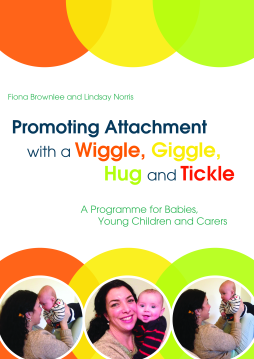
BOOK
Promoting Attachment With a Wiggle, Giggle, Hug and Tickle
Fiona Brownlee | Lindsay Norris
(2015)
Additional Information
Book Details
Abstract
Practical and easy to use, this resource is for practitioners working in early years settings to help children aged 0-2 to develop secure and positive attachments with their parent or carer.
Designed to be flexible for one-to-one or group work, the resource features fun and engaging activities involving singing, movement and sensory activities in a structured but playful environment. It explains the significance of positive attachments in a child's early years, and equips practitioners with skills and techniques to help encourage bonding. It will be of particular interest to those working with parents needing additional support such as vulnerable and adoptive or foster families. The resource is accompanied by online materials - songs to sing along with, and film clips of signing to help parents and carers improve communication. This programme will help parents to become more attuned to the needs of their child, and aid the child's emotional, social and cognitive development.
With additional guidance on how to run the programme as a group, this resource will be easy to use for any health, education or childcare practitioner in specialist and mainstream settings.
A great resource which will help practitioners benefit parents/carers and their children - the theory explained will reinforce practitioners knowledge and the easy style in which it is written makes it an enjoyable process from start to practice.
Jane Comeau, Early Years Professional
Fiona Brownlee was Senior Peripatetic Paediatric Occupational Therapist in the Children and Families Department in Edinburgh, supporting children and staff in the city's early years centres. She is retired after 40 years' working as a therapist.
Lindsay Norris currently works as a Specialist Occupational Therapy Adviser, providing support to a team of Paediatric Occupational Therapists and Community Care Assistants. Previously, she has worked as a paediatric occupational therapist, a community occupational therapist and a senior practitioner occupational therapist.
Promoting Attachment With a Wiggle, Giggle, Hug and Tickle helps carers learn how to tune into their babies physically and emotionally, supporting their ability to understand their needs better and to develop the kind of consistent, loving relationships that have long-lasting benefits for child, carer and ultimately our wider society. This book provides accessible information about attachment, physical development and sensory stimulation and why they are so fundamentally important in a baby's early life.
Anne O'Connor, Principal Consultant, PRIMED FOR LIFE Training Associates
Table of Contents
| Section Title | Page | Action | Price |
|---|---|---|---|
| Acknowledgements | 7 | ||
| Introduction | 9 | ||
| Background | 10 | ||
| Outcomes | 13 | ||
| Positive feedback | 14 | ||
| 1 Attachment | 16 | ||
| Positive attachment | 17 | ||
| Hormones and brain development | 17 | ||
| Reading your child | 18 | ||
| Empathy | 19 | ||
| Negative attachment | 19 | ||
| Lasting effects of a negative attachment | 20 | ||
| Resilience and emotional stability | 21 | ||
| Parent as we have been parented | 21 | ||
| How to encourage positive attachments | 22 | ||
| Insecure and indiscriminate attachments | 22 | ||
| Post-natal depression and attachment | 23 | ||
| Adoptive parents, foster carers and attachment | 24 | ||
| 2 Communication | 25 | ||
| Babies want to communicate | 26 | ||
| Sign and gesture | 26 | ||
| Description of signs | 27 | ||
| Rhyme and song | 30 | ||
| 3 Movement | 32 | ||
| The importance of movement | 33 | ||
| Tummy time | 33 | ||
| Reflexes | 34 | ||
| Positions for play | 36 | ||
| 4 Sensory | 39 | ||
| Sensory processing | 40 | ||
| Intervention | 42 | ||
| Body awareness | 43 | ||
| Balance | 43 | ||
| Touch | 44 | ||
| 5 Play | 45 | ||
| The importance of play | 46 | ||
| Baby play | 46 | ||
| The carer’s role in play | 46 | ||
| Signs of readiness to play | 47 | ||
| Responsive play | 47 | ||
| 6 Child Development \n(0–2 Years) | 49 | ||
| Milestones in child development | 50 | ||
| Developmental delay | 55 | ||
| Developmental age vs developmental stage | 56 | ||
| Physical or learning disability | 56 | ||
| Emotional immaturity | 57 | ||
| 7 Supporting Carers | 58 | ||
| Be consistent and follow a routine | 59 | ||
| Be prepared | 59 | ||
| Session structure | 60 | ||
| Points to remember | 61 | ||
| 8 Running a Group | 63 | ||
| Who can run a group? | 64 | ||
| Where can you run a group? | 65 | ||
| The group – start to finish | 66 | ||
| Preparation | 66 | ||
| Now you can begin! | 67 | ||
| Endings | 70 | ||
| Points to remember | 70 | ||
| The role of the adult | 70 | ||
| Appendix | 72 | ||
| Session Planner | 77 | ||
| Wiggle Giggle Hug and Tickle Invitation | 78 | ||
| Wiggle Giggle Hug and Tickle Confirmation Letter | 79 | ||
| Individual Session Observation Form | 80 | ||
| Completion Certificate | 81 | ||
| Wiggle Giggle Hug and Tickle Evaluation Form | 82 | ||
| About the Authors | 84 |
